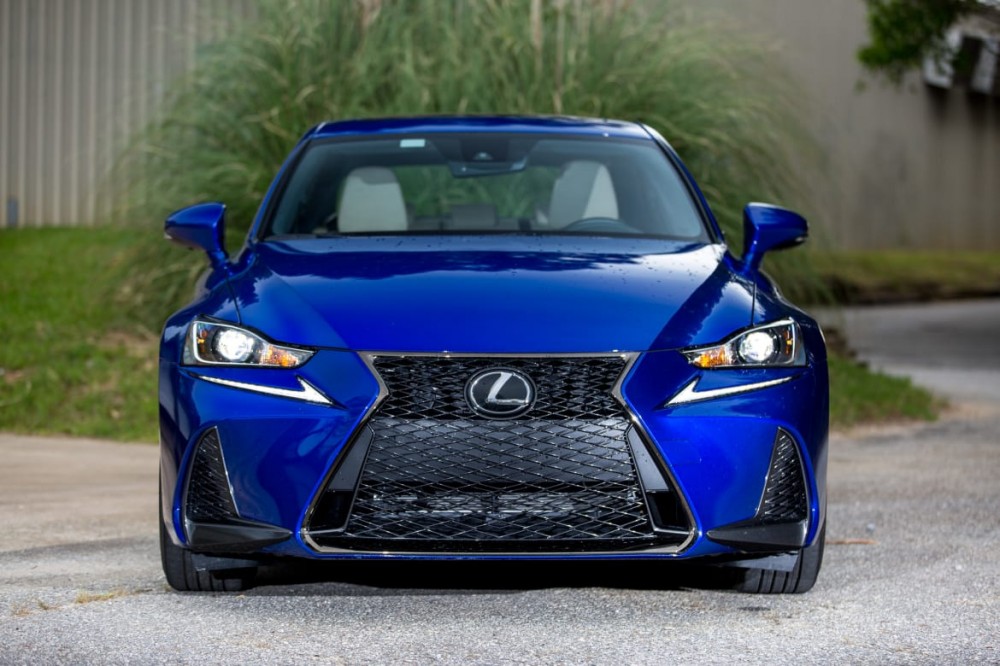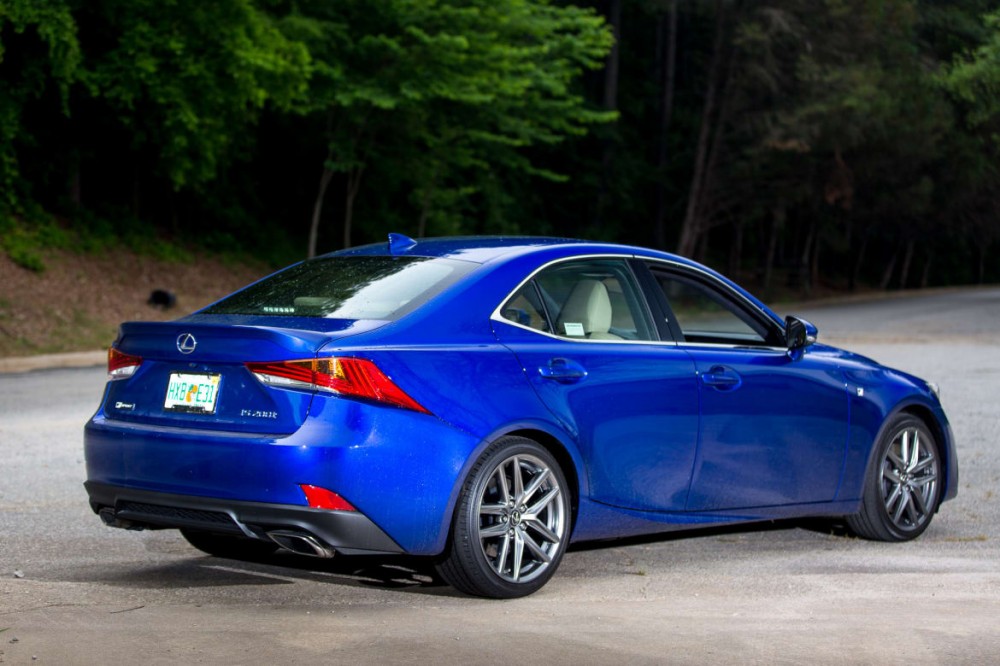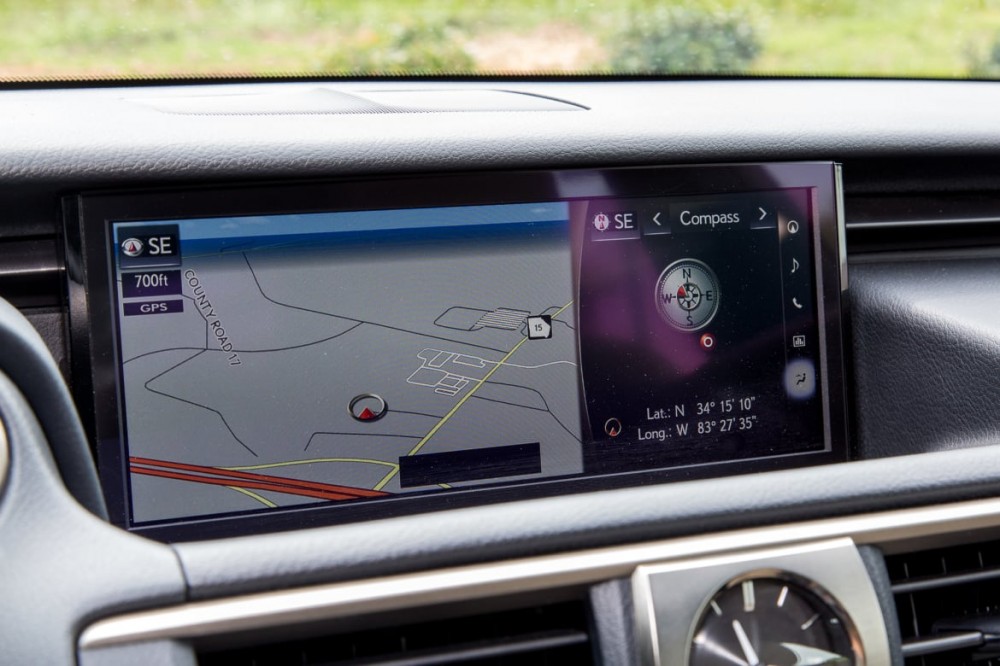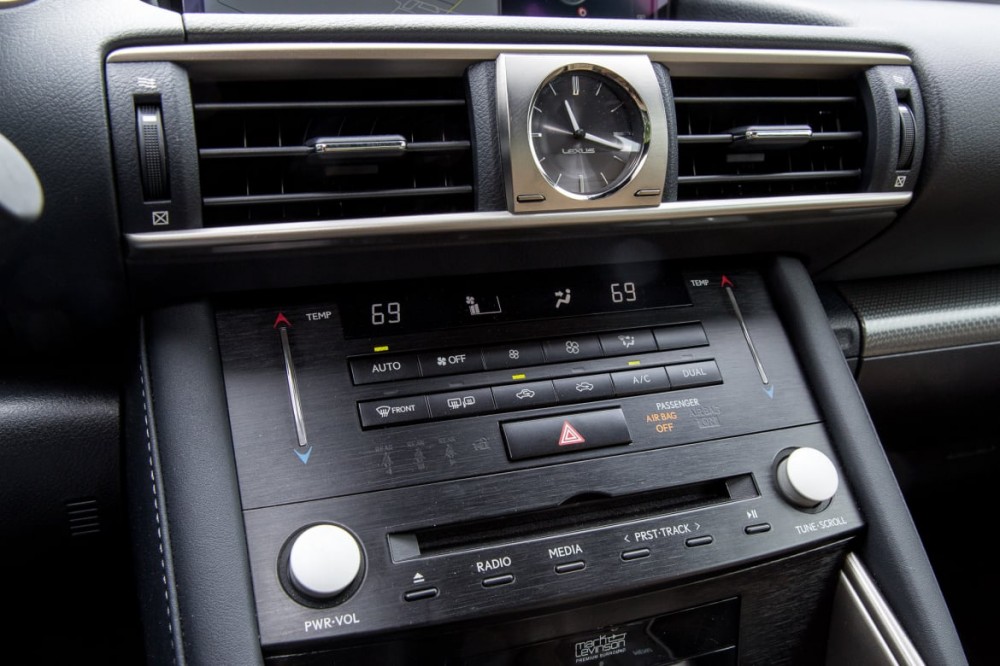The verdict: A weak drivetrain and frustrating controls were two big reasons the 2017 Lexus IS 200t finished last in our recent test of luxury sports sedans, but stepping up to the V-6-powered IS 350 doesn't completely solve the problem.
Versus the competition: While the IS looks the part of a luxury sports sedan thanks to aggressive exterior bodywork, its driving experience comes up short in a class that now, more than ever, is filled with fun-to-drive cars.
The IS comes in three flavors, each with a different drivetrain. The base IS 200t is powered by a 241-horsepower, turbocharged 2.0-liter four-cylinder engine, while the mid-level IS 300 gets a 255-hp, 3.5-liter V-6 and the top IS 350 uses a 306-hp, 3.5-liter V-6. The IS 200t and IS 350 have standard rear-wheel drive and eight-speed automatic transmissions. All-wheel drive is standard on the IS 300 and optional on the IS 350; if you choose AWD, the eight-speed transmission is replaced with a six-speed automatic. Compare these cars' specs here.
We drove an IS 200t with an as-tested price of $47,523 (including a $975 destination charge) and a rear-wheel-drive IS 350 with an as-tested price of $49,579. Options on both cars included navigation, a Mark Levinson premium stereo and the F Sport Package. This performance-oriented package includes a unique grille and front bumper, 18-inch F Sport wheels with all-season or summer tires, heated and ventilated F Sport front seats, aluminum pedals and an F Sport suspension that, in the IS 350, also includes computer-controlled adaptive damping.




How It Drives
In an era of powerful, responsive turbo four-cylinder engines, the IS 200t's underwhelming four-cylinder drivetrain is an outlier. Gas pedal response is very gradual, and power comes on much more slowly than it does in competitors like the Alfa Romeo Giulia, Audi A4 and BMW 330i. The subjective scores and objective performance numbers from our comparison test bear this out: The IS 200t had the lowest-rated powertrain of the seven cars we tested, and it was slowest both to 60 mph (7.6 seconds) and through the quarter-mile (15.5 seconds at 93 mph). Complete performance results for all the cars we tested are available here.
The IS 350's V-6 also underwhelmed. Even though it's rated a healthy 306 hp, it doesn't feel as quick as you'd expect — particularly on the highway. While the IS 350 easily keeps pace with highway traffic in general, when you need more oomph to pass, the V-6's reserve power is modest.
Editors had problems with the eight-speed automatic transmission, too. Though it doesn't make the kind of abrupt, unrefined shifts we've experienced in some high-gear-count transmissions — like the nine-speed automatic in some Jeeps — they complained that the transmission paired with the four-cylinder engine was slow to respond and had trouble picking the right gear. The transmission works better with the V-6, where it readily performed both part-throttle downshifts and full-throttle kickdowns.
In an era of powerful, responsive turbo four-cylinder engines, the IS 200t's underwhelming four-cylinder drivetrain is an outlier.
The IS 200t wasn't particularly fun to drive, either, favoring driver isolation over involvement. There's not a lot of steering feedback, and turn-in is gradual. Editors also dinged the IS 200t's firm, busy ride and overall lack of athleticism. The Cadillac ATS, Giulia and Jaguar XE were much more entertaining.
The IS 350's F Sport suspension is firm. You feel it most when you hit a manhole cover or drive on rougher pavement. Otherwise, the ride is comfortable, controlled and well-suited for long-distance cruising. The suspension doesn't feel different between the Normal and Sport S settings, but the ride is a little harder in Sport S Plus mode.
The IS 200t's EPA-estimated gas mileage of 22/32/26 mpg city/highway/combined is within a few mpg of its four-cylinder competitors. In the IS 350, estimated gas mileage dips to 19/28/22 mpg.
The Inside
Like some of its competitors, the IS' cabin is snug. If you like to sit with the driver's seat raised as I do, the side window and roof won't be far from your head; my head once hit the roof when driving over a big bump (I'm 6-foot-1). There's good legroom in front: The driver's footwell is wide, and the bolstered F Sport seats are soft yet supportive, holding you securely in place when cornering.


With its good legroom and foot space, the backseat is big enough to comfortably seat two adults. It's roomier than the Giulia's or ATS' backseat, but the roof encroaches a bit here, too. The seat cushion is also a little low, resulting in a slightly knees-raised seating position. The center floor hump is extremely large; anyone riding in the middle seat would have to find foot space in the outer footwells.
Folding the standard 60/40-split rear seat reveals a big ledge where the trunk floor and backrest meet, making it difficult to slide a long piece of cargo into the car and shrinking the opening between the trunk and passenger area. You can lock the folding seats from the trunk, which deactivates the cabin seat-release buttons.
Most of the surfaces you touch have a high-grade feel, like the soft-touch trim on the doors. It's consistently applied, so backseat passengers enjoy the same premium materials as those in front. However, the patterned-plastic and silver-colored surfaces look cheap — a problem magnified by competitors like the A4, which includes standard aluminum trim.






The cabin has some unique elements, but they're a mix of hits and misses. One of the hits is the motorized instrument cluster that's included in the F Sport Package. It features a large tachometer and digital speedometer surrounded by a few other data points, like engine temperature and fuel level. Pressing a button on the steering wheel slides the tachometer screen to the right to show additional information, such as radio stations. Lexus could have used a single digital display to create these different views, but the motorized element is a neat touch.
On the other hand, the multimedia system's volume and tuning knobs are a miss. They have a rubberized finish, which is a little odd, and the tops of them are beveled, which gives them a strange feel. We're not fans of the touch-sensitive sliders for adjusting driver and passenger temperature, either.
Undoubtedly the biggest miss is Lexus' frustrating Remote Touch controller, which comes with the optional navigation system but also controls other functions. It's not as bad as the trackpad-style interface in other Lexus models, but the IS' console-mounted, mouselike controller is much harder to use than the 3 Series' iDrive system or the Mercedes-Benz C300's Comand, both of which employ rotary knobs instead.
The biggest issue with Remote Touch is its freeform nature, which creates problems in a moving car. The mouse controller moves a cursor on the dashboard display, and even though the system incorporates haptic feedback, which you feel when the cursor lands on a selection, it still requires too much of your attention and is hard to use by feel alone. The navigation system's 10.3-inch screen is new for the 2017 model year; its high-resolution graphics look great, and a split-screen view makes the most of the widescreen layout.
Safety
The IS received good scores (on a scale of poor, marginal, acceptable and good) in the Insurance Institute for Highway Safety's roof strength test and moderate overlap front and side impact crash tests. It received an acceptable rating in IIHS' small overlap front crash test and for its headlight performance, and its newly standard automatic emergency braking system with pedestrian detection was rated superior, the highest score possible. The National Highway Traffic Safety Administration gave the IS a five-star overall rating — the highest possible — for its crash performance and rollover risk.
The emergency braking system is part of the IS' standard Lexus Safety System Plus, which also includes lane departure warning with steering assist, automatic high-beam headlights and adaptive cruise control. A backup camera and a blind spot warning system with rear cross-traffic alert are optional.
Value in Its Class
It has been a little more than four years since we last compared luxury sport sedans, and a lot has changed since then. While the 3 Series won our test in 2013, it finished second to last this time, just ahead of the IS 200t. Why the fall? The BMW is now one of the older models in the class, and it was beaten by fresher competitors like the redesigned A4 and all-new Giulia.
Last redesigned for the 2014 model year, the IS is also one of the older cars in our comparison test. Even though its turbo four-cylinder drivetrain debuted for the 2016 model year, it didn't do much to help the cause. Whether you're looking for luxury or are more interested in sport in your next compact luxury sedan, you'll have better luck with one of the IS' competitors.



Leave a Reply